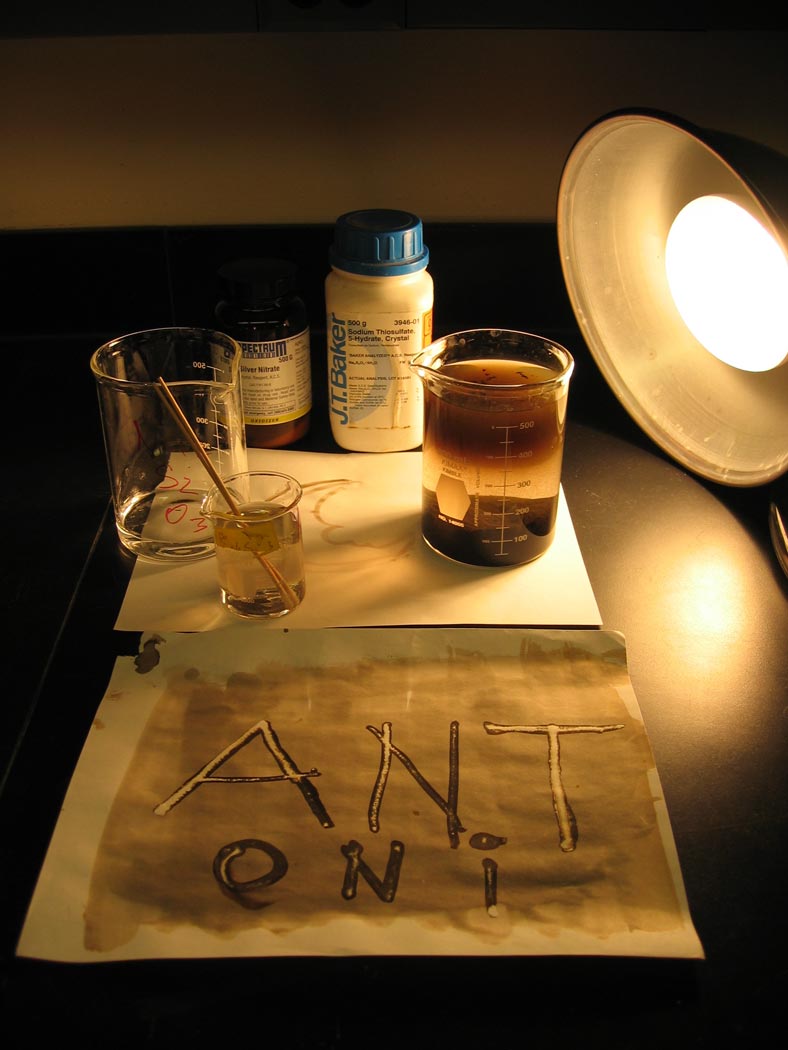The chemistry of photography
 The basic chemistry of exposing and fixing a photographic image is explored.
The basic chemistry of exposing and fixing a photographic image is explored.
Ingredients: silver nitrate, sodium thiosulfate, tungsten light
Procedure: A partial recipe follows.
1. Prepare a solution of silver nitrate.
2. Paint a paper with silver nitrate solution.
3. Expose paper to bright light and observe reaction.
4. In a variation, prepare two papers, each covered with silver nitrate solution.
5. Using a mask, expose a limited region of each paper to bright light.
6. Rinse one paper with sodium thiosulfate solution and leave the other paper as is.
7. Submit the full surface of both papers to the bright light and observe the result.
Understanding: The chemical reaction of the silver salt with light leads to the photoreduction of silver ion to metallic silver
Ag+(aq) → Ag(s)
which is found to precipitate out of solution. It is the formation of metallic silver that is responsible for the brown image that appears on exposure of the silver salt to light. The quantity of silver ion that is photoreduced to silver metal is proportional to the intensity of light.In the experiment using exposure through a mask, the full paper is coated with silver ion. Only the portion of the paper exposed to light is observed to darken, creating a contrast with the unexposed regions, and an image.
Our fully coated paper is similar to a piece of unexposed photographic film. A piece of photographic film might hold silver bromide salt in a gelatin. The film is exposed to a pattern of light. The light ionizes the bromide ion and the freed electron ultimately reduces a nearby silver ion. Some regions of the film are exposed to more intense light than others. The amount of silver reduced in a given region will be proportional to the intensity of light. That variation in intensity creates contrast on the exposed film, and an image.
Before the film can be exposed to more light, the unreacted silver ion must be washed from the film. That is accomplished during the fixing process when the film is treated with sodium thiosulfate solution known as photographic hypo. The hypo binds the unreacted silver ion, leading to the formation of the dithiosulfatoargentate complex ion
AgBr(s) + 2 S2O32-(aq) → Br-(aq) + Ag(S2O3)23- (aq)
Once the silver ion is removed through the fixing process, the film may be safely exposed to light.Note that this process creates a negative of the image. It is the brightest regions that lead to the darkest portions of the image. In the printing process, the image is corrected to create a positive with the contrast and brightness of the original image.
Before the modern photographic process, there was the daguerreotype. To make a daguerreotype, a copper plate covered with metallic silver is treated with iodine vapor, creating light-sensitive silver iodide. Exposure to light reduces the silver ions. The plates are developed using mercury vapor; the mercury combines with silver to create a milky-white amalgam. The milky-white amalgam of silver and mercury creates a visible contrast with the dark copper plate. The images are "fixed" by rinsing away the silver ion using a solution of a common salt, followed by hot distilled water. In the process of creating a daguerreotype, we produce no negative. The positive image is created directly on exposure of the prepared plate to light.
Taking note of light-sensitive compounds
Question: Nearly two thousand years ago, Pliny the Elder (23-79 CE) noted that a certain compound, believed to have been silver chloride, would darken when exposed to the Sun. It would be another 1800 years before the photographic process would be invented and made practical.Given elemental silver, what is a straightforward way to make silver chloride? How would you make silver nitrate? What about silver sulfate? What do those chemical processes have in common? And which one of the salts produced is soluble?
You can check your answers here.
You can check your answers here.
The positive and the negative in photography
Question:
In producing a daguerreotype, we observe that no negative is created. In the modern photographic process, a negative is created and the positive image is produced from the negative. The two images differ in a fundmental way that has nothing to do with chemistry. How so?